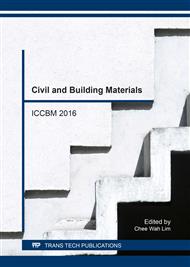[1]
Wang L, Ueda T. Mesoscale modeling of water penetration into concrete by capillary absorption. Ocean Eng. 38, 519–528(2011).
DOI: 10.1016/j.oceaneng.2010.12.019
Google Scholar
[2]
Yu H, Hartt WH. Modeling corrosion initiation of reinforcing steel in concrete: effect of non-diffusive coarse aggregate. J Compos Mater. 45, 153–169(2011).
DOI: 10.1177/0021998310371549
Google Scholar
[3]
Thomas de Larrard, Benoit Bary, Erwan Adam, Francis Kloss. Influence of aggregate shapes on drying and carbonation phenomena in 3D concrete numerical samples. Compu. Mate. Sci. 72, 1–14(2013).
DOI: 10.1016/j.commatsci.2013.01.039
Google Scholar
[4]
G. Lilliu, J.G. van Mier, 3D lattice type fracture model for concrete. Eng. Fract. Mech. 70, 927–941(2003).
DOI: 10.1016/s0013-7944(02)00158-3
Google Scholar
[5]
H. -K. Man, J.G.M. van Mier, Influence of particle density on 3D size effects in the fracture of (numerical) concrete. Mech. Mater. 40, 470–486(2008).
DOI: 10.1016/j.mechmat.2007.11.003
Google Scholar
[6]
P. Grassl, H.S. Wong, N.R. Buenfeld, Influence of aggregate size and volume fraction on shrinkage induced micro-cracking of concrete and mortar. Cem. Concr. Res. 40, 85–93(2010).
DOI: 10.1016/j.cemconres.2009.09.012
Google Scholar
[7]
A. Idiart, J. Bisschop, A. Caballero, P. Lura, A numerical and experimental study of aggregate-induced shrinkage cracking in cementitious composites. Cem. Concr. Res. 42, 272–281(2012).
DOI: 10.1016/j.cemconres.2011.09.013
Google Scholar
[8]
J. -J. Zheng, X. -Z. Zhou, Y. -F. Wu, X. -Y. Jin, A numerical method for the chloride diffusivity in concrete with aggregate shape effect. Constr. Build. Mater. 31 , 151–156(2012).
DOI: 10.1016/j.conbuildmat.2011.12.061
Google Scholar
[9]
L. Basheer, P.A.M. Basheer, A.E. Long, Influence of coarse aggregate on the permeation, durability and the microstructure characteristics of ordinary Portland cement concrete. Constr. Build. Mater. 19, 682–690(2005).
DOI: 10.1016/j.conbuildmat.2005.02.022
Google Scholar
[10]
SHAH S P. High performance concrete: Past, present and future [C]/ LEUNG C K Y, LI Z, DING J T, eds. High Performance Concrete-Workability, Strength and Durability. Hong Kong: Hong Kong University of Science and Technology, 3-29(2000).
Google Scholar
[11]
D.N. Winslow, M.D. Cohen, D.P. Bentz, K.A. Snyder, and E.J. Garboczi, Percolation and pore structure in mortars and concrete, Cem. Concr. Res. 24, 25-37(1994).
DOI: 10.1016/0008-8846(94)90079-5
Google Scholar


